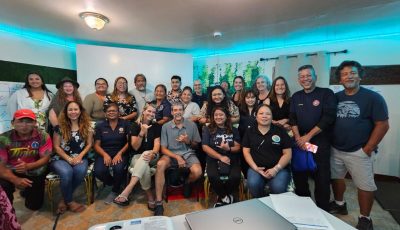Muña: CHC closely monitoring the spread of chikungunya virus
Commonwealth Healthcare Corp. CEO Esther Muña assured yesterday that the corporation is closely monitoring the spread of the chikungunya virus, which, according to Secretariat of the Pacific Community, has now reached half of the Pacific Island countries.
The chikungunya virus causes fever and joint pain. It also causes headache, muscle pain, joint swelling, and rash. Although it is not deadly, the pain caused by the virus can be painful and last several months, affecting daily activities and livelihoods of sick people and communities.
Muña said they are aware of the virus spreading rapidly throughout the Pacific, the closest being Yap and the Marshall Islands. She said there has been no reported case in the CNMI yet.
“CHCC has a surveillance team and a newly hired epidemiologist that will be ready and prepared to respond,” Muña said.
Warren Villagomez, director of the CHCC Public Health and Hospital Emergency Preparedness Program, said that CHCC monitors all patient access and sentinel sites for any infectious diseases.
“Our ‘All Hazard Infectious Disease Response Team’ is standing by for any reported cases. The team is composed of medical and non-medical personnel who are trained to investigate and provide direct immediate care,” Villagomez said.
According to an SPC statement on Tuesday, the chikungunya virus is projected to continue to spread for some years due to a number of factors, mainly the low immunity of the populations in non-affected countries.
Those with fever or joint pains after travelling to countries where chikungunya circulates can avoid spreading the disease by immediately seeing their doctor.
However, while chikungunya is preventable, it is not treatable. There is no vaccine to prevent or medicine to treat the virus yet.
Prevent, symptoms
The Centers for Disease Control and Prevention says mosquitoes that spread chikungunya bite aggressively during the day. The best way to avoid infection is to prevent mosquito bites. It advises the following:
• Use air conditioning or window/door screens.
• Use mosquito repellents on exposed skin. Repellents containing DEET, picaridin, IR3535, and some oil of lemon eucalyptus and para-menthane-diol products provide long lasting protection.
• Wear long-sleeved shirts and long pants or permethrin-treated clothing.
• Empty standing water from outdoor containers.
Symptoms usually begin three to seven days after being bitten by an infected mosquito.
The most common symptoms are fever and severe joint pain, often in the hands and feet. Other symptoms may include headache, muscle pain, joint swelling, or rash.
Most patients will feel better within a week. Some people develop longer-term joint pain that can last weeks to months. Death is rare but can occur.
People at increased risk for severe disease include newborns exposed during delivery, older adults (65 years), and people with medical conditions such as high blood pressure, diabetes, or heart disease.



























